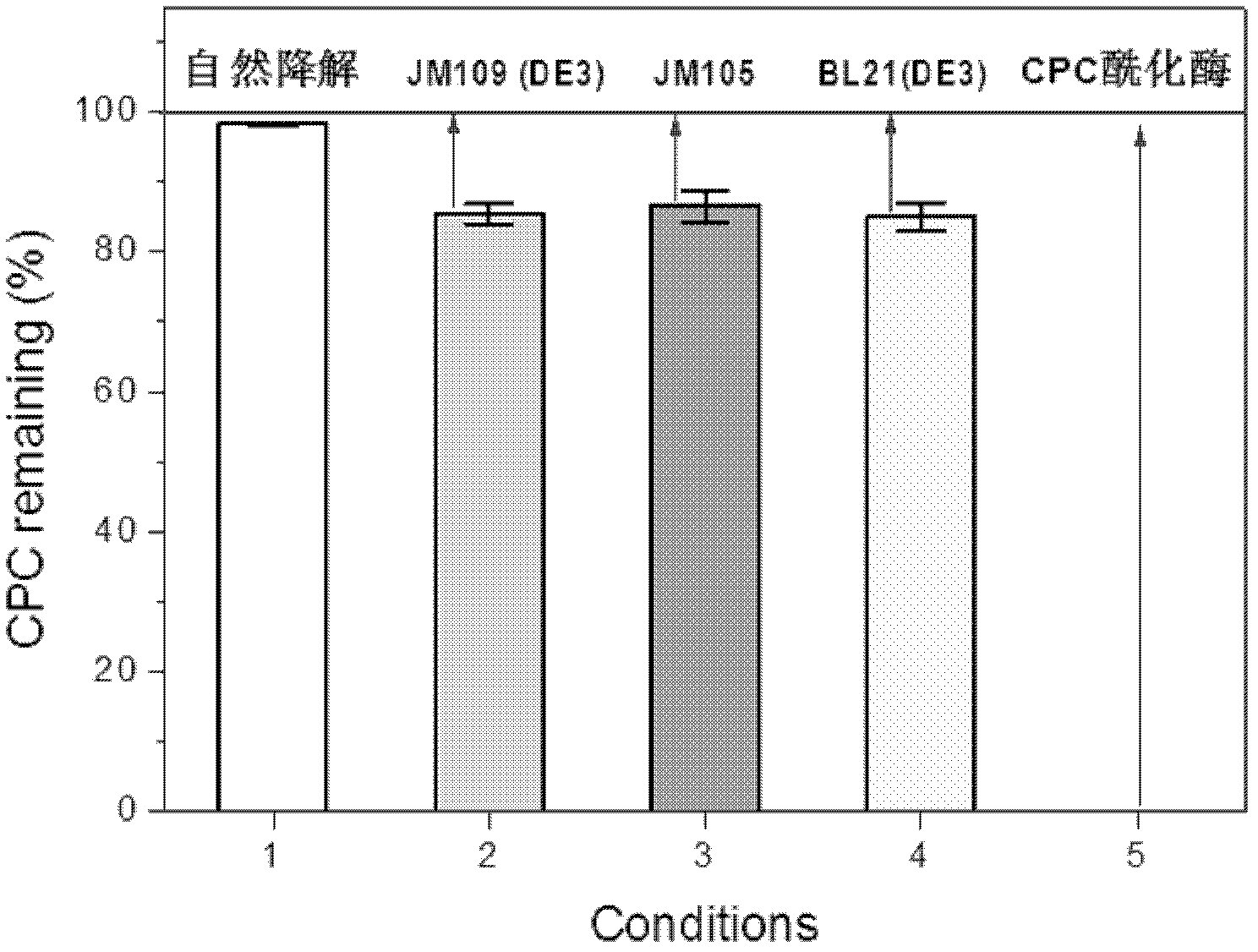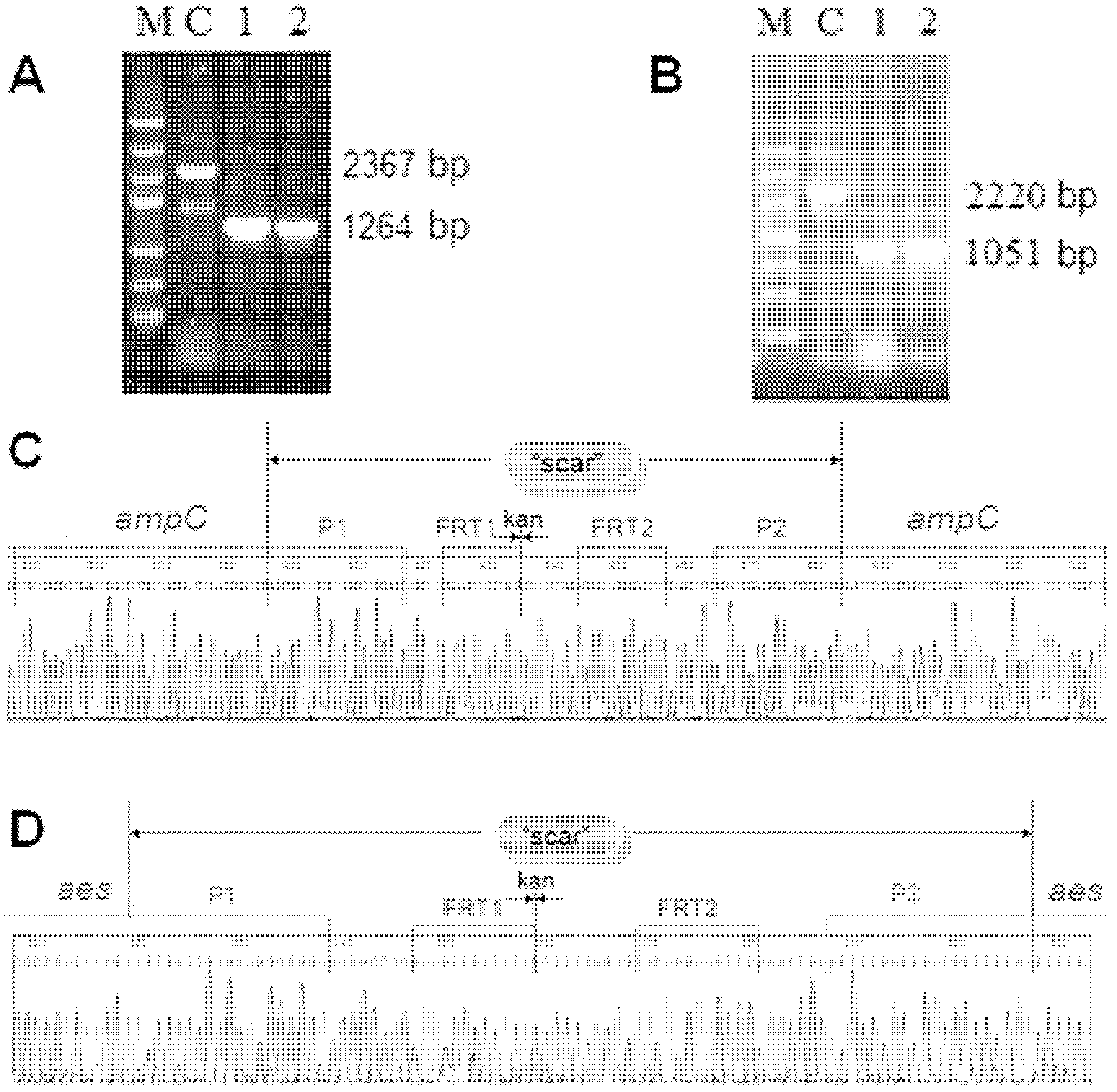Method for reducing decomposition of cephalosporin C
A cephalosporin and host bacteria technology, applied in the field of bioengineering, can solve the problems of reducing the decomposition of cephalosporin C and low utilization rate of CPC, and achieve the effects of improving the utilization rate of substrates, simplifying the production process and reducing the cost of raw materials
- Summary
- Abstract
- Description
- Claims
- Application Information
AI Technical Summary
Problems solved by technology
Method used
Image
Examples
Embodiment 1
[0031] Decomposition of CPC by E.coli JM105 (Cyberson Corporation), JM109(DE3) (Dingguo Corporation) and BL21(DE3) (Promega Corporation) Cell Lysate
[0032] (1) Preparation of cell lysate and crude enzyme solution:
[0033] In 10ml LB medium containing 50mg / L kanamycin (medium composition is: peptone 10g.L -1 , yeast powder 5g.L -1 , sodium chloride 10g.L -1 , pH 7.0) were inoculated with single colonies of E. coli JM105, JM109 (DE3) and BL21 (DE3) respectively, cultured at 37°C and 200rpm for 12h to make seed flasks. Take 1mL of bacterial solution and transfer it to 50mg.L -1 kanamycin in 50 ml (300 ml shake flask) fermentation medium. Among them, the inducible medium of Escherichia coli JM109 (DE3) and BL21 (DE3) is: corn steep liquor 50g.L -1 , Yeast paste 10g.L -1 , NH 4 Cl 2.5g.L -1 , glycerol 5g.L -1 , KH 2 PO 4 2.3g.L -1 , K 2 HPO 4 .3H 2 O 20.4g.L -1 , lactose 3g.L -1 , pH 7.5. The constitutive medium of Escherichia coli JM105 is: corn steep liquor ...
Embodiment 2
[0039] Knockout of β-lactamase and acetylesterase in E. coli JM105 and JM109(DE3)
[0040] (1) Knockout of β-lactamase gene ampC:
[0041] The genome sequence analysis of E.coli K12 showed that the β-lactamase gene ampC (E.coli K12 gene ID948669) and the acetylesterase gene aes coexisted in the genomes of E.coli JM105 and JM109(DE3) (E. coli K12 gene ID 947514). Homologous arm primer pair ampCP1 / ampCP2 was designed, containing 40bp upstream and downstream fragment of ampC gene and 19bp kanamycin resistance gene fragment, respectively, and was synthesized by Yingweijieji Bioengineering Technology Co., Ltd. (Beijing). Using the helper plasmid pKD13 as a template, a DNA fragment containing the kanamycin resistance gene inside and the ampC homology arm outside was amplified. PCR amplification adopts 50μL system, the composition is as follows:
[0042]
[0043]
[0044] Among them, rTaq DNA polymerase and dNTPs were purchased from Takara Company (Dalian).
[0045] The ups...
Embodiment 3
[0056] Decomposition of CPC by Cell Lysate of β-lactamase and Acetylesterase Knockout Engineering Bacteria
[0057] According to the method described in Example 1, cultivate the following three kinds of β-lactamase and acetyl esterase knockout type engineering bacteria E.coli JM105 (ΔampC), E.coli JM105 (Δaes), E.coli JM105 ( ΔampC, Δaes), and E.coli JM105 was used as the control. Determination of cell growth curves, such as Figure 4 A shown. The results showed that knockout of β-lactamase and acetylesterase had no significant effect on the growth of recombinant bacterial cells. According to the method as described in Example 1, the cell lysate of each bacterial strain was prepared, and the cell lysate of the bacterial strain before natural degradation and double enzyme knockout was used as a control to investigate the effect of each cell lysate CPC decomposition, the results are as follows Figure 4 Shown in B. The E.coli JM105 cell lysate without gene knockout degrades ...
PUM
 Login to View More
Login to View More Abstract
Description
Claims
Application Information
 Login to View More
Login to View More - R&D
- Intellectual Property
- Life Sciences
- Materials
- Tech Scout
- Unparalleled Data Quality
- Higher Quality Content
- 60% Fewer Hallucinations
Browse by: Latest US Patents, China's latest patents, Technical Efficacy Thesaurus, Application Domain, Technology Topic, Popular Technical Reports.
© 2025 PatSnap. All rights reserved.Legal|Privacy policy|Modern Slavery Act Transparency Statement|Sitemap|About US| Contact US: help@patsnap.com



